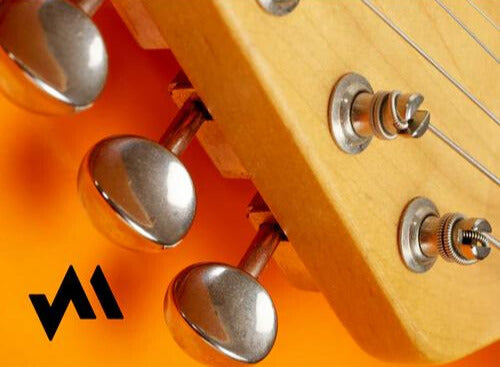Alternate Tunings (and Why You Should Try Some)

Chances are you’ve spent a good deal of time learning to play in standard tuning, you know your way around the fretboard and maybe you can confidently take a solo... so why abandon all that knowledge and start from scratch learning new chord shapes and scale positions? There can be any number of reasons, but perhaps the most popular has to do with sparking creativity.
If you are a songwriter and you’re trying to come up with a musical idea that you haven’t written or haven’t heard before, you want to take yourself outside your comfort zone. If you’re in a tuning you’re familiar with, you are more likely to gravitate toward what you already know how to play, but if you’re in an unfamiliar tuning, you might stumble on something new simply by moving your hands around the fretboard and seeing what sounds surprise you. In other words, the appeal of alternate tunings is: you don’t know what you’re doing.
Plenty of songwriters have employed this method to great effect, experimenting with all sorts of alternate, and sometimes invented tunings to come up with what are now famous songs. Joni Mitchell, Chris Cornell, Jimmy Page, and the Tallest Man On Earth are a few examples. Other guitarists become familiar with one secondary tuning in addition to standard for the purpose of sonic variety - this is a good idea for those of us who cannot afford to bring a dozen guitars in various tunings to a gig, or who don’t want to spend most of the show retuning! For example, Tom Morello frequently uses Drop D, and Joe Walsh keeps a guitar in open E for slide solos. A few notable guitarists have taken a particular tuning and become so proficient at it that it has become associated with them, such as Keith Richards’ 5-string Open G, or Duane Allman’s Open E.
If you are curious about the world of alternate tunings, here are a few songs to get you started. Most of these tunings can be achieved by retuning a standard set of strings, but if you are planning on tuning any string more than a whole step away from standard, or if you want to retune a guitar permanently, you may want to research what gauge, or thickness, of strings work best for which tuning.
Tuning #1: Drop D - Low to High DADGBE
Example: Everlong - Foo Fighters
Probably the most used, and most accessible tuning for guitar is Drop D. Simply detune the low E down to a D and you’re there. The most common application for this tuning is barring the bottom 3 strings on any fret to create an easy power chord, allowing for complex riffs to be played in fifths with that heavy sound. However, this tuning can also be used to play softer, acoustic music, unlocking spacier voicings. A good example of this is the song Everlong by the Foo Fighters. The voicings in the intro, formed by two fifth intervals stacked, form an open-voiced sus-2 chord, a unique sound when moved around the fretboard.
There are hundreds of other good examples of this tuning in basically any style, but two others are Never Going Back Again by Fleetwood Mac (fingerpicking) or Killing in the Name by Rage Against the Machine.
Tuning #2: DADGAD
Example: Kashmir - Led Zeppelin
Once you’ve become comfortable with Drop D, you’re just two strings away from DADGAD! Sometimes called Celtic tuning, because of its popularity with guitar players for accompanying Celtic fiddle tunes, this tuning is easy to remember because the instructions are right there in the name. Simply retune the first, second, and sixth strings one whole step down from standard. In my opinion, this is the most likely tuning to grab random shapes on and have it sound cool. Just look at maybe the most famous mainstream example, Led Zeppelin’s Kashmir. That cool, complicated sounding descending riff is actually just a two string riff, moved around the fretboard!
A few other examples of this tuning include Ed Sheeran’s “Photograph” and Neil Young’s “Goin’ Back”.
Tuning #3: Open E - EBEG#BE
Example: Big Yellow Taxi - Joni Mitchell
An “Open” tuning is one in which all the strings are tuned to the notes of one chord, usually major, so that different chords can be achieved simply by barring all strings at different frets. For this reason, open tunings are particularly favoured by slide guitarists, because they allow for full chords to be played using only the slide. You can retune to open E by raising the fifth and fourth strings a whole tone, and the third string a semitone (the same arrangement of intervals a whole step down, or Open D, is also common). Noted tunings-explorer Joni Mitchell used Open E for her biggest hit, Big Yellow Taxi. Listen to the way she frets a few notes over the open chord to bring cool suspensions and inversions into the groove.
Check out how Bo Diddley uses open E for his eponymous hit, or an example on bottleneck slide, listen to “Statesboro Blues” by the Allman Brothers Band.
While these 3 common tunings are sure to expand your playing and maybe inspire an idea or two, they are really just an introduction into the expansive world of alternate tunings. The possibilities are essentially limitless, but here are a few more examples that may inspire you.
- Start Me Up - Rolling Stones - DGDGBD
- Cinnamon Girl - Neil Young - DADGBD
- Burden In My Hand - Soundgarden - CGCGGE
- Suite: Judy Blue Eyes - Crosby Stills & Nash - EEEEBE
- Rain Song - Led Zeppelin - DGCGCD
---
Rob McLaren is a guitarist and lover of all things stringed, you can catch him playing guitar with Union Duke or picking the banjo with his bluegrass outfit the Barrel Boys
Want to level-up your playing? Pre-order your Jamstack 2 amp today!



